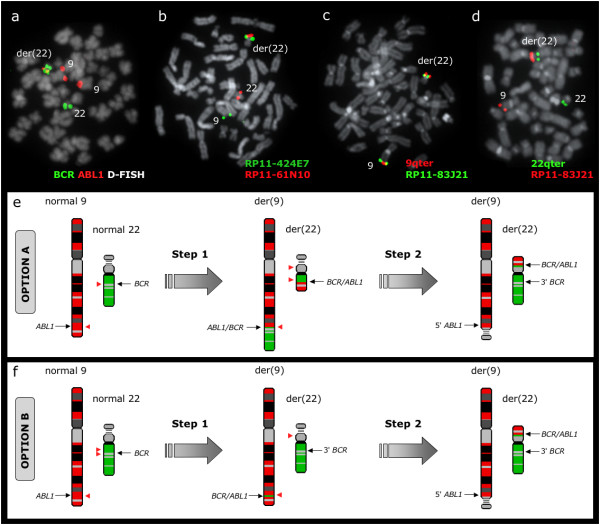Figure 6.
BCR/ABL1 fusion resides at 22p11 in patient no 7. (a) BCR/ABL1 D-FISH probe (Vysis) showing a split green signal from BCR within the masked Ph. There is only 1 fusion signal located at der(22), another green signal at the same (der22), one green signal at normal 22 and 2 red signals at both chromosomes 9. (b) A representative metaphase cell with co-hybridization of FISH probes RP11-424E7 and RP11-61N10 identifying both probes at the p arm of the masked Ph. (c) A representative metaphase cell with co-hybridization of a 9q sub-telomeric probe (Stretton) and RP11-83J21, showing the presence of the two probes at 22p11 and indicating that all sequences distal to ABL1 breakpoint had moved to 22p11. (d) A representative metaphase cell with co-hybridization of a 22q sub-telomeric probe (Stretton) and RP11-83J21, showing that the 22q telomere is retained at its original location. (e) Schematic representation of the events that may have lead to the formation of BCR/ABL1 fusion gene and its unusual location at 22p11, with chromosome 9 in red and 22 in green. Sequences distal to BCR breakpoint are found at their original location while 5' BCR and 9q34 sequences distal to ABL1 breakpoint (including the telomere) are relocated at 22p11. This could be explained by an initial t(9;22)(q34;q11) followed by a three-way translocation between 9q34, 22q11 and 22p11, which would require 5 breaks (red arrowheads). (f) The unusual location of BCR/ABL1 at 22p11 could also be a result of an initial ins(9;22)(q34;q11q11) followed by a translocation between der(9) and the p arm of der(22). This sequence of events would need also the same amount of breaks (red arrowheads) and therefore cannot be rule out.

